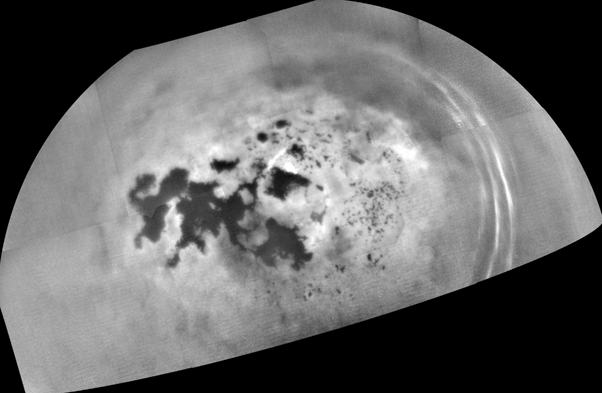It’s just as well a mission to Saturn’s moon Titan was confirmed this year, because the observations we have reveal the most Earth-like world we know still contains many mysteries. Just a month after evidence that waves on Titan are eroding the shorelines of its biggest lakes, a new study reports that even on its seas, waves would be barely visible. Either one study is wrong, or there’s a lot of power in these tiny ripples.
Titan is far too cold for liquid water, at least at the surface, but it has lakes of liquid hydrocarbons, three of which are large enough to be called seas. It’s far from a second Earth, but it’s the closest thing we will get for a very long time, given the obstacles to interstellar travel, and serves as something for a model for Earth’s earliest years.
These ethane and methane bodies are intriguing enough that we’re sending the Dragonfly mission to check them out. One of the major questions is how large the waves can get on their surfaces. They’re similar in size to the Great Lakes of North America and Africa, where storms can sink large ships. A recent study suggested the same might be true for Titan, based on erosion around the edges of the largest bodies. However, science’s greatest strength is that conclusions are not dogma and can be challenged, particularly from a single paper.
Using radar observations made by the Cassini mission of Titan’s polar seas a team led by Dr Valerio Poggiali of Cornell University found the roughness on Kraken, Ligeia, and Punga Mare was measured in millimeters.

The images Cassini returned of Kraken and Ligeia Seas don’t show much detail, but radar indicates they hosted not so large waves.
Image credit: NASA/JPL-Caltech/Space Science Institute
Although such ripples would be unlikely to make even a sailor particularly prone to seasickness nauseous, in certain coastal areas they may reach as large as half a centimeter (0.2 inches). That’s still tiny, but may be indicative of strong local currents. If you found a wetsuit protective enough to let you swim in lakes 180°C below zero (-290°F), you’d still need to worry about being swept away from shore by a rip.
The authors also found signs that estuaries where rivers enter the lakes and seas have more methane and less ethane than the usual, like brackish intakes of salty seas. This makes sense, because rain on Titan is mostly methane and nitrogen, producing methane rivers carrying dissolved nitrogen gas. Just as fresh water entering salty bodies on Earth does not mix instantly, the same appears true for Titan’s hydrocarbons.
It’s been eight to 18 years since Cassini made the observations Poggiali and co-authors used in their paper, but the study used the 13 bistatic radar observations Cassini made with its Radio Science Subsystem. Previous analysis had often relied on monostatic observations, which the authors argue mixes the effects of surface roughness and chemical composition so that the two cannot be distinguished. The bistatic measurements look only at the very surface of the liquids.
Big waves on Titan’s seas are considered plausible, since its dunes appear to be sculpted by strong winds. However, these dunes are mostly close to the equator, while the largest bodies of liquid are at the poles.
The study is published open access in Nature Communications.
Source Link: Titan’s Not For Surfing, Even If You Could Stand The Cold